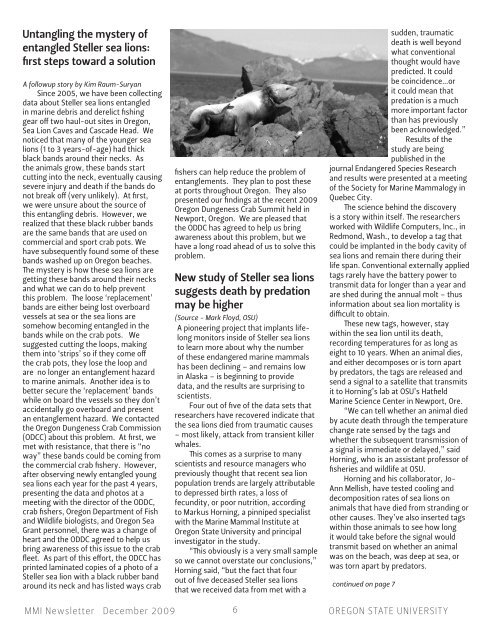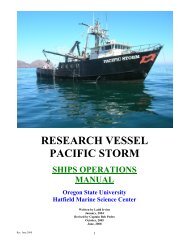Newsletter 4 - Marine Mammal Institute - Oregon State University
Newsletter 4 - Marine Mammal Institute - Oregon State University
Newsletter 4 - Marine Mammal Institute - Oregon State University
You also want an ePaper? Increase the reach of your titles
YUMPU automatically turns print PDFs into web optimized ePapers that Google loves.
Untangling the mystery of<br />
entangled Steller sea lions:<br />
first steps toward a solution<br />
A followup story by Kim Raum-Suryan<br />
Since 2005, we have been collecting<br />
data about Steller sea lions entangled<br />
in marine debris and derelict fishing<br />
gear off two haul-out sites in <strong>Oregon</strong>,<br />
Sea Lion Caves and Cascade Head. We<br />
noticed that many of the younger sea<br />
lions (1 to 3 years-of-age) had thick<br />
black bands around their necks. As<br />
the animals grow, these bands start<br />
cutting into the neck, eventually causing<br />
severe injury and death if the bands do<br />
not break off (very unlikely). At first,<br />
we were unsure about the source of<br />
this entangling debris. However, we<br />
realized that these black rubber bands<br />
are the same bands that are used on<br />
commercial and sport crab pots. We<br />
have subsequently found some of these<br />
bands washed up on <strong>Oregon</strong> beaches.<br />
The mystery is how these sea lions are<br />
getting these bands around their necks<br />
and what we can do to help prevent<br />
this problem. The loose ‘replacement’<br />
bands are either being lost overboard<br />
vessels at sea or the sea lions are<br />
somehow becoming entangled in the<br />
bands while on the crab pots. We<br />
suggested cutting the loops, making<br />
them into ‘strips’ so if they come off<br />
the crab pots, they lose the loop and<br />
are no longer an entanglement hazard<br />
to marine animals. Another idea is to<br />
better secure the ‘replacement’ bands<br />
while on board the vessels so they don’t<br />
accidentally go overboard and present<br />
an entanglement hazard. We contacted<br />
the <strong>Oregon</strong> Dungeness Crab Commission<br />
(ODCC) about this problem. At first, we<br />
met with resistance, that there is “no<br />
way” these bands could be coming from<br />
the commercial crab fishery. However,<br />
after observing newly entangled young<br />
sea lions each year for the past 4 years,<br />
presenting the data and photos at a<br />
meeting with the director of the ODDC,<br />
crab fishers, <strong>Oregon</strong> Department of Fish<br />
and Wildlife biologists, and <strong>Oregon</strong> Sea<br />
Grant personnel, there was a change of<br />
heart and the ODDC agreed to help us<br />
bring awareness of this issue to the crab<br />
fleet. As part of this effort, the ODCC has<br />
printed laminated copies of a photo of a<br />
Steller sea lion with a black rubber band<br />
around its neck and has listed ways crab<br />
fishers can help reduce the problem of<br />
entanglements. They plan to post these<br />
at ports throughout <strong>Oregon</strong>. They also<br />
presented our findings at the recent 2009<br />
<strong>Oregon</strong> Dungeness Crab Summit held in<br />
Newport, <strong>Oregon</strong>. We are pleased that<br />
the ODDC has agreed to help us bring<br />
awareness about this problem, but we<br />
have a long road ahead of us to solve this<br />
problem.<br />
New study of Steller sea lions<br />
suggests death by predation<br />
may be higher<br />
(Source - Mark Floyd, OSU)<br />
A pioneering project that implants lifelong<br />
monitors inside of Steller sea lions<br />
to learn more about why the number<br />
of these endangered marine mammals<br />
has been declining – and remains low<br />
in Alaska – is beginning to provide<br />
data, and the results are surprising to<br />
scientists.<br />
Four out of five of the data sets that<br />
researchers have recovered indicate that<br />
the sea lions died from traumatic causes<br />
– most likely, attack from transient killer<br />
whales.<br />
This comes as a surprise to many<br />
scientists and resource managers who<br />
previously thought that recent sea lion<br />
population trends are largely attributable<br />
to depressed birth rates, a loss of<br />
fecundity, or poor nutrition, according<br />
to Markus Horning, a pinniped specialist<br />
with the <strong>Marine</strong> <strong>Mammal</strong> <strong>Institute</strong> at<br />
<strong>Oregon</strong> <strong>State</strong> <strong>University</strong> and principal<br />
investigator in the study.<br />
“This obviously is a very small sample<br />
so we cannot overstate our conclusions,”<br />
Horning said, “but the fact that four<br />
out of five deceased Steller sea lions<br />
that we received data from met with a<br />
sudden, traumatic<br />
death is well beyond<br />
what conventional<br />
thought would have<br />
predicted. It could<br />
be coincidence…or<br />
it could mean that<br />
predation is a much<br />
more important factor<br />
than has previously<br />
been acknowledged.”<br />
Results of the<br />
study are being<br />
published in the<br />
journal Endangered Species Research<br />
and results were presented at a meeting<br />
of the Society for <strong>Marine</strong> <strong>Mammal</strong>ogy in<br />
Quebec City.<br />
The science behind the discovery<br />
is a story within itself. The researchers<br />
worked with Wildlife Computers, Inc., in<br />
Redmond, Wash., to develop a tag that<br />
could be implanted in the body cavity of<br />
sea lions and remain there during their<br />
life span. Conventional externally applied<br />
tags rarely have the battery power to<br />
transmit data for longer than a year and<br />
are shed during the annual molt – thus<br />
information about sea lion mortality is<br />
difficult to obtain.<br />
These new tags, however, stay<br />
within the sea lion until its death,<br />
recording temperatures for as long as<br />
eight to 10 years. When an animal dies,<br />
and either decomposes or is torn apart<br />
by predators, the tags are released and<br />
send a signal to a satellite that transmits<br />
it to Horning’s lab at OSU’s Hatfield<br />
<strong>Marine</strong> Science Center in Newport, Ore.<br />
“We can tell whether an animal died<br />
by acute death through the temperature<br />
change rate sensed by the tags and<br />
whether the subsequent transmission of<br />
a signal is immediate or delayed,” said<br />
Horning, who is an assistant professor of<br />
fisheries and wildlife at OSU.<br />
Horning and his collaborator, Jo-<br />
Ann Mellish, have tested cooling and<br />
decomposition rates of sea lions on<br />
animals that have died from stranding or<br />
other causes. They’ve also inserted tags<br />
within those animals to see how long<br />
it would take before the signal would<br />
transmit based on whether an animal<br />
was on the beach, was deep at sea, or<br />
was torn apart by predators.<br />
continued on page 7<br />
MMI <strong>Newsletter</strong> December 2009<br />
6 OREGON STATE UNIVERSITY






